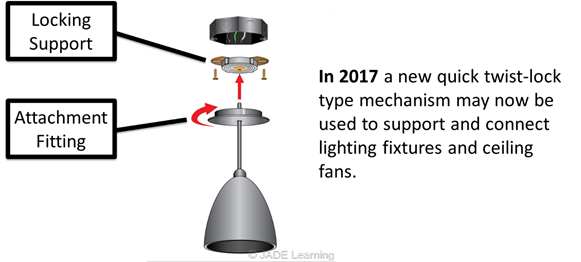NEC 314.27 (E) Luminaire and Fan Separable Attachment Fittings

By: Robert Key | Oct 30, 2019
The demand for quick, easily changeable lighting fixtures has led to the development of products consisting of an electrical receptacle with a locking device capable of supporting the luminaire weight. That receptacle also makes and breaks the electrical contacts responsible for feeding the luminaire. The load-bearing portion of this new component, called the mounting support, is installed in the ceiling box and includes the energized receptacle contacts that will feed the lighting fixture or ceiling fan. An attachment fitting that connects to the mounting support and the energized contacts built into that support is incorporated into the design of the lighting fixture or fan. The fixture or fan attaches to the mounting support with a twist lock motion. These new attachment fittings can save valuable time when installing lighting outlets.
Lighting outlets with these energized locking receptacles and the compatible luminaires they feed were first introduced during the 2017 Code cycle in Section 314.27(E) Separable Attachment Fittings.
These unique, separable attachment fittings must be listed and compatible with the other components.
Here is the Code language found at NEC 2017 section 314.27(E)
Section 314.27(E) Separable Attachment Fittings.
Outlet boxes required in 314.27 shall be permitted to support listed locking support and mounting receptacles used in combination with compatible attachment fittings. The combination shall be identified for the support of equipment within the weight and mounting orientation limits of the listing. Where the supporting receptacle is installed within a box, it shall be included in the fill calculation covered in 314.16(B)(4).
All portions of this new product that are installed within the outlet box must be included when performing the box fill calculation. This typically will mean the mounting plate portion, and its volume in cubic inches should be marked on the mounting plate so that the box fill can be calculated.
This new product also produced changes in other portions of the Code. The definition for “Receptacle” found in Article 100 was altered in 2017 to accommodate this new method of connection.
- 2014 definition: A receptacle is a contact device installed at the outlet for the connection of an attachment plug.
- 2017 definition: A contact device installed at the outlet for the connection of an attachment plug, or for the direct connection of electrical utilization equipment designed to mate with the corresponding contact device.
Also, for the 2020 NEC, Section 410.36 specifies that these locking support and mounting receptacle outlets used to connect luminaires are considered lighting outlets and can be used to satisfy the requirements for lighting outlets found in Section 210.70
410.36(A)(3) states: Outlet boxes complying with 314.27(E) shall be considered lighting outlets as required by 210.70(A), (B), and (C).
These changes to other portions of the Code are important since they promote consistency and make the requirements easier to understand for the electrician and AHJ.
Changes in Code language and requirements not only improve safety, but are also necessary when new products are introduced, such as separable attachment fittings. This new way of attaching luminaires or ceiling fans to outlet boxes with a simple twist lock motion has the potential to greatly simplify the final trim out process. It is our responsibility to make sure that the installation of these products is safe and code-compliant.


Thank you for this informative article. There is one correction I would like to point out to keep the description of the illustration accurate.
The description you give for the pendant light attachment with this new system shown is a direct “plug in” application. It is not a twist-lock motion. You can rotate it but the connection and lock is made by a straight plug in motion and does not require a twist motion or rotation to engage.
Please let me know if you have any further information on this new and exciting innovation for the lighting and electrical industries. It is certainly needed for safety concerns.
Thanks again,
Alan Kramen
Electrical Inspector, Sunny Isles Beach,Fl.